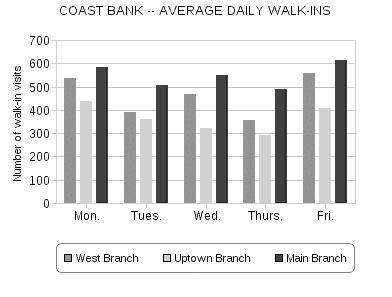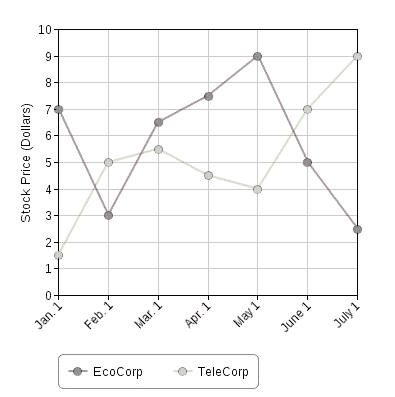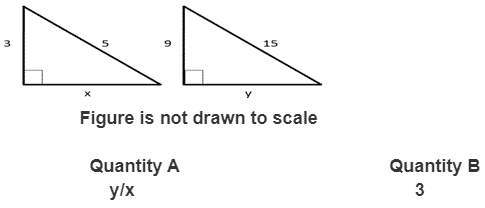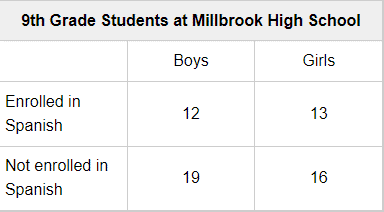GRE Practice Test (Quantitative Reasoning Test)
Which of the following best describes the average daily number of walk-in visits to the Uptown branch during a normal week, according to the graph?

Explanatory Answer
At the Uptown branch (represented by the light gray bars), the average number of walk-in visits are as follows
(visual approximations will suffice):
Monday: 440
Tuesday: 360
Wednesday: 320
Thursday: 290
Friday: 410
The question asks for the average of these five numbers. Their total is 1,820. Their average is 1,820 ÷ 5 = 364. Of the five
choices, (B) supplies the closest value and hence is the correct response.
The size of one interior angle in a parallelogram surpasses the size of another interior angle by D degrees. Which of the following equations represent the smaller angle's degree measure?
Explanatory Answer
Let x equal the degree measure of the smaller angle, and let (x + D) equal the degree measure of the larger angle.
The two angles are by definition supplementary, which means that their degree measures total 180:
x + (x + D) = 180
Solving for x yields the expression in choice (C), which is the correct answer.
The per-share prices of EcoCorp and TeleCorp stock at the start of each of the first seven months of year X are plotted in the graph.
Which of the following months' per-share price of EcoCorp stock increased or decreased by more than two dollars, each month analyzed separately?
Indicate all such months.

Please select 4 correct answers
Explanatory Answer
To answer the question, refer to the dark trend line. During January, February, May and June the share price of EcoCorp
stock changed by more than two dollars. During March and April the change was less than two dollars. The correct answer
is (A), (B), (E) and (F). You would gain credit for answering the question correctly only by selecting all four of these choices
but no others.
Compare Quantity A and Quantity B, using extra information centered above the two quantities, and choose
one of the four answer options:
A symbol that comes in a question more than once has the same meaning throughout.
The following equation represents Line A:
10y + 20x = 50
Quantity A: The y-intercept of Line A
Quantity B: The slope of Line A
Write the equation for Line A in slope-intercept form: y = mx + b where m is the slope and b is the y-intercept.
10y + 20x = 50
10y = -20x + 50
y = -2x + 5
Therefore, the slope of Line A is -2 and the y-intercept of Line A is 5. Hence quantity A is greater.
Compare Quantity A and Quantity B, using extra information centered above the two quantities, and choose
one of the four answer options:
A symbol that comes in a question more than once has the same meaning throughout.

Explanation:
The ratio of the sides of both triangles is 3:4:5. Therefore, x = 4 and y = 12. Since y/x = 3, both quantities are equal.
Compare Quantity A and Quantity B, using extra information centered above the two quantities, and choose
one of the four answer options:
A symbol that comes in a question more than once has the same meaning throughout.
For the first half of the year, the following table shows the revenue Jack's business generated and the proportion
of that revenue he paid in taxes.
Quantity A: The average of the income tax Jack paid
Quantity B: 22% of Jack’s average income
Calculate the income tax Jack paid each month by multiplying the percentage paid in taxes by the monthly income earned.
Jack’s average income tax is (1,000 + 15,000 + 4,000 + 1,000 + 6,000 + 36,000)/6 = $10,500.
Jack’s average income is (10,000 + 50,000 + 20,000 + 10,000 + 30,000 + 90,000)/6 = $35,000, and 22% of $35,000 = $7,700.
Therefore, quantity A is greater.
What is the ratio of p/q if q is the smallest composite number bigger than 2 and p is the smallest prime number less than 10?
A prime number is a positive integer that is divisible by exactly two numbers: 1 and itself. A composite number is a positive integer that is divisible by more than just 1 and itself. The number 1 is neither prime nor composite. The smallest composite number greater than 2 is 4, and the smallest prime number less than 10 is 2. Therefore, p = 2,q = 4,and p/q = 1/2 = 0.5
Advertisement
From a group of seven male and five female students, a mixed team of four young researchers will be selected.

Explanation:
Start off by finding the number of groups which can be formed having 3 females out of 5. i.e. (5*4*3)/(3*2*1)= 10.
Now, we multiply it by the total number of male students who can be coupled in to form a group of total four members.
Therefore, 10*7 = 70.
As 70 > 66, so Option (a) is correct.
Compare Quantity A and Quantity B, using any extra information available. Choose one of the four answer options.
Choose the correct answer.

Explanation:
We know that circumference of a circle equals 2πr. Here, r= 3 so the circumference equals 18 approximately. Now,
Perimeter of a square is equal to sum of all its sides, which in this case is 16.
So, we say that Option (B) is correct because Quantity A is greater than Quantity B.
There are 30 animals in a certain Zoo, 14 of which prefer to eat white meat and 13 of which prefer to eat grains. 9 animals despise both white meat and grains.

Explanation:
The easiest and the most time efficient way to solve these group questions is to simply substitute the value in the formula i.e.
Total = Group 1 + Group 2 – Both + Neither
30 = 14 + 13 – Both + 9
Both = 6
So, the animals which eat both kinds of food are 6.
We chose option A as our correct answer.
Assume that the sum of three consecutive numbers equals zero. These are the integers a, b, and c. a*b*c=0

Explanation:
From the given data, it is not clear what is the value of 'a'. The only thing which is given to us is that the product of these
three numbers is zero which means that these numbers could be -2,-1,0 or -1,0,1, or 0,1,2. Therefore, we chose option (C)
From the provided quantities, select the correct solution.

Explanation:
This is a simple question but most of the candidates will waste their time on this type of question by adding all numbers
and then comparing. However, you need to save your time in these types of questions. You note that all the numbers in
quantity B are greater than respective numbers in quantity A so you don't need to add the numbers. Therefore, option
(A) is correct.
Select the appropriate option.

Explanation:
Most of the students would select Option (A) for this question because there are more fractions in it but it's wrong.
You must not waste your time in these types of questions but at the same time, you have to be careful. If you observe
carefully, you will note that both these quantities are equal to 1. So, we choose option (D).
The arithmetic mean of five numbers equals 100. Choose the proper option based on the information provided.
Quantity A: Sum of these number
Qunatity B: 133
Explanation:
Now let's read the given information once again carefully. We know that arithmetic mean of 5 numbers equals the sum
of those 5 numbers divided by 5. Now, we have the arithmetic mean equal to 100 as given. This means that, sum of these
numbers is 100*5 = 500.
Now we know that 500 > 133, so we chose option (B).
Advertisement
Consider the equation below and select the correct answer.
14- 5x > 7
Quantity A: x
Quantity B: 2
Explanation:
14-5x > 7 -> -5x > 7-14 -5x > -7 -> x < 7/5
If x < 7/5, then x must also be less than 2. So, we choose option A.
A + B equals three, while A - B equals four. Choose the proper option based on the information provided.
Quantity A: A
Quantity B: B
Explanation:
In order to solve this question, you have to find the values of A and B. From first equation, we get to know that A = 3 – B.
So we put this value of A in second equation, which becomes, 3- B – B = 4, solving this equation, we get -2B = 1 i.e. B= -1/2.
And A = 7/2. So option (B) is correct
g and h are positive integers with g twice the value of h.
Quantity A: The ratio of g to 1
Quantity B: The ratio of 1 to h
Explanation:
Plug In for this question. Let h = 3, which makes g = 6. Quantity A equals 6/1 = 6 and Quantity B equal 1/3.
Quantity A can be greater than the Quantity B, so eliminate (B) and (C). Because g and h are positive integers,
Quantity A will always be greater than 1 and Qunatity B will always be less than or equal to 1. Quantity A will
always be greater than the Quantity B.
The total weight of recycled newspaper in one country rises by 0.79 million tons every year.
Quantity A: The percent increase in the weight of recycled newspaper in 1989 over 1988
Quantity B: The percent increase in the weight of recycled newspaper in 1990 0ver 1989
Explanation:
Say there were 10 million tons in 1988. The percent increase was 0.79/10. Then 1989 there were
10.79 tons, so the percent increase from 1989 to 1990 was 0.79/10.79.
Quantity A must be greater
Anthony has a six-sided dice with numbers 1 through 6 on each side. He makes two rolls of the die.
Quantity A: The probability the he rolls two even numbers
Quantity B: The probability that neither number rolled is a multiple of 3
Explanation:
For Quantity A, there are three ways to get an even numbers (these are 2,4,6). So, the probability of
"rolling an even" and then "rolling an even" is 3/6 x 3/6 = 1/4.
For multiple independents events, multiply the probabilities. For Quantity B, there are four ways to not
get a multiple of 3 (these are 1,2,4,5). The probability of "not rolling a multiple of 3" and the "not rolling
a multiple of 3" is 4/6 x 4/5 = 4/9.
Quantity B is greater than Quantity A.
The male to female employee ratio at a telephone firm was 8 to 9. After some time had passed, ten more employees were hired,
six of whom were male and four of whom were female.
Quantity A: The number of male employees after hiring was complete
Quantity B: The number of female employees after hiring was complete
Explanation:
As given in the statement of the question, the ratio of male to female employees was 8 to 9 which means that if there
were 8 male, there were 9 female. Similarly, for 16 male, there would be18 female or we can say that for 24 male, there
would be 27 female. Now after the hiring process was complete, 6 male and 4 female were hired, which could make the
total 14 male and 13 female, or maybe 22 male and 22 female, or maybe 30 male and 31 female. As the total number of
employees is not given, we can't be sure which of these is correct. Therefore, we select option C.
We have a 16-foot hardwood board that we cut into five equal halves, with a shorter length left over. Which of the
following alternatives is the correct answer?
Quantity A: Length of one part of wooden plank
Quantity B: 3
Explanation:
Most of the students will just note the power of 'a' and choose option (A) but that is wrong. You must note that a>0
means that 'a' could possibly be 1 as well. And if a=1, Quantity A and Quantity B are equal. Therefore, we choose option
(C), as we don't exactly know whether a=1 or a>1.
Advertisement
Every day, talk show presenter Jhonny Brown has precisely one guest on his show, which airs Monday through Friday. Brown has ploticians on Mondays and Wednesdays, actors on Tuesdays, and athletes on Thursdays, but he can have a visitor of any of these three types on Friday. On Burke's show, no guest appears more than once a week. How many distinct schedules of guests might Burke construct from Monday to Friday if he had five politicians, three actors, and six athletes to invite, and if no politician is also an actress or an athlete, and no actor is also an athlete?
Explanation:
Make a spot for each day and fill in the numbers of guest who could occupy that spot. Brown has 5 choices
for Monday, 3 choices fro Tuesday, 4 choices for Wednesday (because one politician was chosen on Monday),
6 choices for Thursday, and 10 choices for Friday (because 4 of the 14 potential guset have already been chosen)
Multiply these to arrive at 3,600 different schedule.
How many granddaughters did Jhonny have if he had 12 grandchildren and three times the number of grandsons?
Explanation:
Rather than assigning separate variables to the granddaughters and grandsons, define them both in terms of the
same unknown multiplier, based on the ratio given:
Number of granddaughters = 3m
Number of grandsons = m
Note that you are solving for 3m, not for m!
3m + m = 12
4m = 12
3m = 9
Alternatively, suppose that Nash had exactly one grandson and three granddaughters.
That would sum to four grandchildren altogether. Triple the number of grandsons and granddaughters to
triple the number of grandchildren.
A is 6 units away from B and B is 2 units away from C on a number line. What is the distance between the two points A and C?
Explanation: br> There is no rule that A,B, and C must occur in alphabetical order. If the points are ordered A,B, C, the distance from .4 to C is 6 + 2 = 8. But if in the order A, C,B, the distance from A to C is 6—2 = 4. Any other orders allowed by the relative distances ( C,B,A, for instance, or B, C,A) will also yield either 4 or 8.
What percentage of Millbrook High School's 9th-grade Spanish students are boys?

Explanation:
There are 60 total students and 12 boys enrolled in Spanish. The answer is 15/60, which reduces to
1/5 (Read carefully! “What fraction of the students are boys who are enrolled in Spanish?" is NOT
the same as “What fraction of the boys are enrolled in Spanish?”)